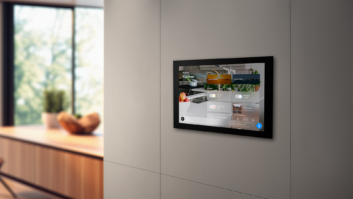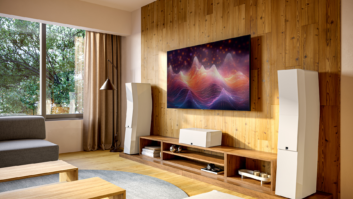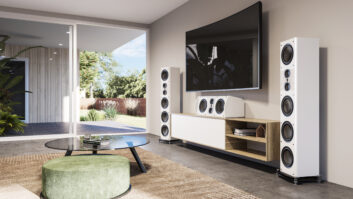by John Sciacca
For many home theater aficionados—including 26 of the 29 projects up for the 2011 CEDIA Electronic Lifestyles awards — the height of awesometopia is a media room with an anamorphic-lens-equipped front-projection system. As I happen to have such a system, I thought I would first explain why they are so slathered in awesome, and then explain why I think this bit of technology might be headed towards extinction.
Now, I realize that the concept of how an anamorphic lens system functions has been covered many, MANY times out there. But for the benefit of anyone who wants a refresher, or for just an excuse to show you three different screen shots from the new Empire Strikes Back Blu-ray, here is a description with visual play-by-play of exactly how the anamorphic projection process works.
Step 1: Original, unaltered widescreen video:

This is an image of how most people would watch movies that are in Cinemascope or Widescreen (2.35 – 2.40 aspect ratio) format. You have several inches of black bars at the top and bottom of the image, meaning that it does not fill the entire viewing area of your 1.77 x 1 (aka 16×9) HDTV video screen. Instead of precious RGB videos, your TV is wasting real-estate showing…black bars. And if there is one thing that Americans seem to be able to rally their hate around, it is for black bars on their TV sets! The “white” viewing area of my Draper movie screen measures 45 inches tall x 80 inches wide x 92-inches diagonal when masked to 16×9 aspect. When I watch Empire unaltered on this screen the actual image is 36.5 inches tall x 80 inches wide x 87-inches diagonal. The height suffers the most, losing 8.5 inches. Worse, the image looks noticeably smaller than a regular TV show, which DOES fill the screen. And if George Lucas has taught us anything, it is that blockbuster films like Star Wars should not look smaller but rather BIGGER. (And that you should always get the merchandising rights. And that a movie if never, ever, never-never-ever truly finished being made and that people love you to tinker with their beloved childhood memories.)
Step 2: Vertically stretch the image:

The scaler in my Marantz projector vertically stretches the image so now it fills the entire height of my projection screen. Since the width stays the same, this means that now the image is distorted. Circles appear more oval and AT-AT walkers appear tall and gangly. (Super models, however, tend to look even more super. It’s an odd phenomena.)
Step 3: Optically stretch the image horizontally:

Just like in a commercial theater, a special anamorphic lens slides in front of the regular lens that optically (no video processing that can further degrade the image) stretches the image wider so that it returns to the correct geometry. Circles are once again circular and AT-ATs are returned to Rebel scum destroying armored walkers of mechanized awesome! The motorized lens sled receives a trigger from the projector and does this whenever I press a button labeled “Cinemascope.” When I finish with the movie, the lens slides back out of the way and images return to their native, unstretched state. But when the lens is in place…

…instead of viewing Empire as an image that is a “puny” 36.5 x 80 x 87 inches (H x W x Diagonal) or 2920 square inches I am now viewing it on a screen that measures 45 x 106 x 115, or a whopping 4770 square inches! It appears WAY larger BECAUSE IT IS! And it delivers a far more cinematic experience. Widescreen movies get bigger and more impressive instead of smaller than an episode of Real Housewives.
So, you’re probably thinking – if you’ve hung with me this far, and, come on, hasn’t it been just kinda interesting? Yeah, I thought so! — if this is so awesome, why doesn’t everyone have one and why would I say that it is headed towards extinction?
Problem numero uno is the cost. Big chunks of high precision glass optics are not cheap. In fact, they are really expensive. Plus there is probably a supply-and-demand thing at work here where they haven’t developed tons of factories in China to bang these things out. Either way, a Panamorph lens (like the UH480 that I own in the picture) sells for around $5000. Yes. I know. A lot. Nothing about the phrase “precision optics” implies low-low bargain prices. The higher end Schneider-Isco lens is closer to $10,000. Yes. That’s *just* the lens, and doesn’t include the projector. Also not included? The cool motorized sled thingy that moves the lens in and out of the way. That will run you another few grand. So, tack on an extra $8-13 grand on top of the price of a decent projector and you see why this has *maybe* not started appearing in all the local Wal-Marts.
Problem the second is the look/size of this fantabulous contraption. You can’t really tell from that head-on picture but that lens adds another giant element to a fairly large item that is already probably hanging from the ceiling in a room in where the client said, “You are going to hang…THAT!…on my ceiling…where people will see it?!?” The first time I unboxed the projector and attached the lens in my living room I had that kind of weird gut flip-flop that usually precedes the brain formulating the thought, “Oh…my…GOD!!! What have I done?!” Are the results cool? To be sure. Does this Franken-lens-rig LOOK cool when it’s not in use? Only to dyed-in-the-wool technophiles.
Also not so great is that anamorphic lenses eat up about 10% of the projector’s brightness and reduce contrast ratio. They can also affect color and grayscale and introduce artifacts like pin-cushion and bowing in the image.
But the cost and the look alone are not enough to render these babies obsolete. For movie lovers looking for the closets thing to a truly cinematic experience at home, the lens is where it’s at… for now. What is going to make these babies go bye-bye in my opinion is the further advancement of technology. And, from how I’ve seen it work, that isn’t necessarily a bad thing.
The Ol’ Stretch and Zoom
An alternative way to getting the same anamorphic experience would be to simply zoom the picture out until the black area filled the top and bottom portion of the screen. Do a a little bit of focus fine-tuning and voila! You have a “poor man’s” anamorphic solution! Except it kind of totally sucks to have to get up and fiddle with your lens all the time; adjusting the zoom and focus, probably touching up the vertical shift, maybe a little digital blanking to get rid of any overscan. That’s exactly the kind of thing that is likely to earn you an exasperated, “Come on! I just want to watch the movie! Aren’t you done fiddling with that thing yet?!” Also, the lenses on alot of projectors just don’t have the lens throw flexibility to allow them to have any kind of positioning flexibility to support both 16×9 and 2.35:1 projection from the same location.
The solution would be to equip the projector with a lens that has a lot of adjustment range and then build some memory settings into the projector coupled with an auto-adjusting lens that would allow it to have different settings for zoom, focus, shift, (probably some brightness and contrast tweaks as well) for both 16×9 and 2.35. Then at the touch of a button the lens could just automatically zoom in and out to exactly where it needs to be for either aspect.
This is actually a terrific solution to the problem, eliminating the cost – and Star Destroyer hanging from the ceiling look – of the second lens. It also eliminates the scaling artifacts that happen from the vertical stretch process, allowing the image to remain in dot-by-dot, perfect pixel, unscaled format. (Joe Kane – either “video guru” or “video Nazi” depending on who you ask – greatly prefers this method.) (Actually, to be totally honest, Joe Kane prefers two completely separate projectors located in their respective lens-throw sweet spots and calibrated and optimized for either 16×9 or 2.35. But, the two-projector method is a REALLY tough sell.)
The first example I saw of a projector capable of doing this was at a Panasonic press event at CES a few years ago. “Brilliant!” I thought. But it never really seemed to catch on. But now, it finally seems to be. This year I saw multiple projectors – most notably Sony, JVC and Panasonic – that were extolling the virtues of this feature. I saw the JVC in action and while it was inexplicably slow and clunky in its changeover process (and bizarrely through up a series of seemingly totally unnecessary test patterns each time) the end result was very much how my own lens-equipped system works. I can only imagine and hope that they will straighten this process out and speed it up in shipping models.
One of the drawbacks to this method in the past was the “light spill” from the “black” area projected above and below the screen could be extremely distracting. Since the letterboxed “black bar” area is actually still being projected (just zoomed out to beyond the area of the screen) and since it was not ACTUALLY black but rather just a ultra-dark, kind of glowing grey, this was unacceptable to videophiles. But now that some LCOS technology projectors are approaching 100,000:1 contrast ratios (I know, the number is ridiculous, but the blacks ARE getting amazingly close to true 0 IRE levels) the light spray is virtually imperceptible.
We’re Gonna Need a Bigger Chip
The second solution would be to just accept the fact that they way to project a wide rectangle from a rectangle is to just a wider rectangle. In other words, build a new chip that uses a native 2.35 aspect ratio. Since the height stays constant, it could use only the center part of the chip area when showing 16×9 content. And if the chip’s resolution was high enough, the 16×9 area could still display a full 1920 pixels, meaning that no resolution would be lost or sacrificed. Then for 2.35 content the full width of the chip could be utilized. That would be pretty cool, right?
This is exactly what Sim2 and Digital Projection International (DPI) are hatching. (I seriously JUST took that word from Terra Nova. I’m so impressionable.) Both of these companies are early adopter partners with Texas Instruments – the sole manufacturer of DLP chips – and they are going to feature TI’s new native WQXGA 2560 x 1600 DLP chip. This will allow full resolution presentations of both 16×9 and 2.35 material without any lens zooming, stretching, re-focusing OR any light spill. (From my understanding, some physical locking or blockage occurs on the chip when it is in 16×9 mode, completely shutting off the wide portion of the chip and not having any light spill from the “dead,” unused pixels.) The Sim2 version will be called the Nero 235 and the DPI model the dVision Scope 1080p.
I saw the dVision Scope system in action at CEDIA and I have to say it was impressive. The projector senses the aspect ratio of the video material, and then automatically switches to use the appropriate portion of the chip. This switchover is very quick and totally silent. Here’s a video I took of the dVision Scope in action:
Initiate CinemaScape K-scaling
A final new method for handling anamorphic projection doesn’t so much eliminate a lens system, (though I believe it probably *could* by using the zoom out method) as it eliminates the need to have a sled that moves the lens in and out of the way. Kaleidescape demonstrated a new soon-to-be-released feature for their movie server system at this year’s CEDIA. This feature will allow users with an anamorphic lens system to get a new GUI that is specially created for the wider, 2.35:1 aspect ratio; it will show more cover art, and ALL of the list info (title, actors, directors, rating, release year, genre, run time) on the screen when browsing. It will also reposition subtitles for any of those pesky films that decide that the subtitles should be repositioned from their theatrical release into the black area below the film. (Stupid filmmakers, changing their movies for the home release!) Since Kaleidescape has the metadata on like every movie and KNOWS what the correct aspect of every film is, the system will automatically adjust between 2.35 and 1.85/1.78 content, allowing an anamorphic lens to always remain in place, making operation easier and more foolproof for owners. The Kaleidescape system will then digital stretch, compress, scale the images to make sure that they are always displayed in correct geometry with the lens in place all the time. Kaleidescape feels that the process of selecting the proper lens setting, and moving the lens in and out can often be confusing to some tech-challenged owners and that “CinemaScape eliminates this disruptive glitch by performing the necessary video processing” allowing users to leave the lens in place all the time which will make system operation easier and ensure proper presentations.
Whichever of these solutions end up prevailing – current lens/sled, zoom and refocus memory, or dedicated widescreen chips – the exciting thing is that more attention is being paid to this and that (hopefully) more people will be able to experience a first rate theatrical presentation while staying at home. Now, make sure you’ve got a good supply of booze on hand!







